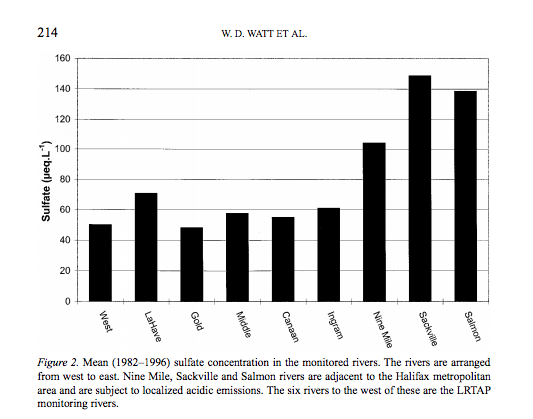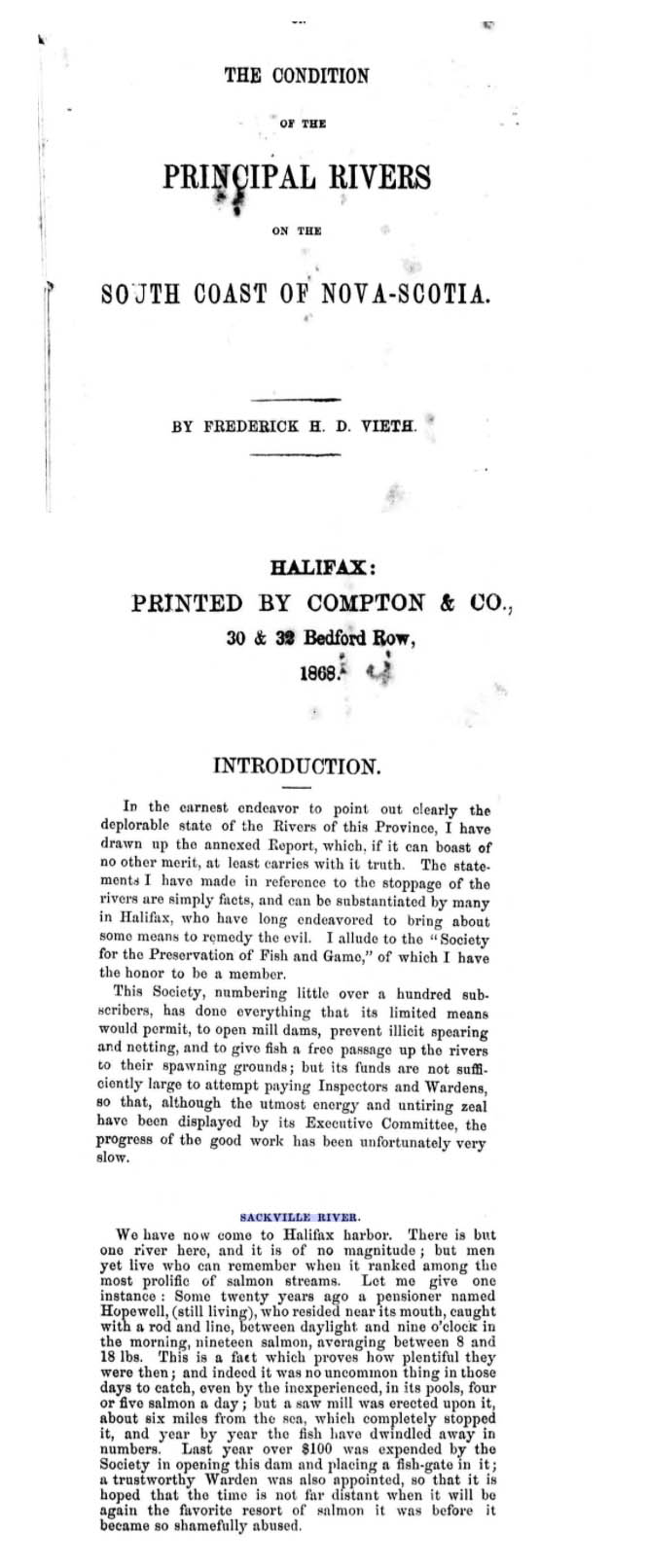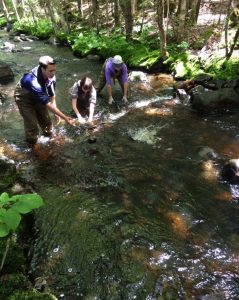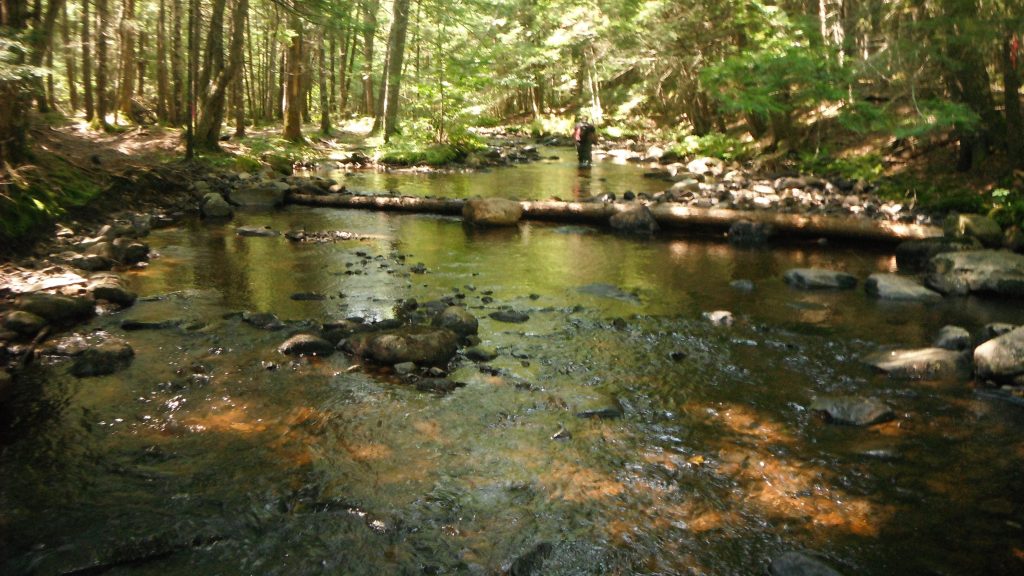CONTENTS
1. The Salmon Life Cycle
2. Salmon in Sandy Lake
3. Overviews of Atlantic Salmon
4. Beaver Dams
5. Sackville River Association Documents
6. More about salmon in the Sackville River Watershed
7. More on Acidification
A Subpage: Natural – On the Natural History of the Sackville River
1. The Salmon Life Cycle
From Miramichi Salmon Association: Life Cycle of the Atlantic Salmon
Most Atlantic salmon are anadromous, meaning they undergo their greatest feeding and growth in salt water; however, adults return to spawn in native freshwater streams where the eggs hatch and juveniles grow through several distinct stages.POST-HATCH STAGES:
Alevin – Newly hatched young with unabsorbed yolk sac, also called sac fry.
Fry – Salmon that have absorbed their yolk sacs, emerged from the gravel and are ready to feed.
Parr – Older juveniles with prominent parr marks.
Smolt – Young salmon that are ready to go to sea.
Grilse – Atlantic salmon that have spent one winter in the sea and have returned to the fresh water to spawn.
Multi-sea-winter salmon – A fish that has spent at least two years at sea before returning to fresh water to spawn. Included are fish that maiden (first time) spawners as well as previous spawners.
Kelts (black salmon) – salmon which have spawned and are still in freshwater or returning to the sea.
2. Salmon in Sandy Lake
– A salmon jumped right out of the water in Sandy Lake!
Post on September 26, 2019/ “…About 10 days ago, a salmon was sighted in a “classic pose” jumping right out of the water at Sandy Lake. As I was told the story 2nd or 3rd hand and reported initially, I understood that the fish observed jumping was an older salmon, but that stands corrected. I contacted the observer who told me:
“I’m certain it was a grilse—not an adult salmon. It jumped clear of the water and I happened to be looking in that direction and saw it in perfect profile. After having fished the diminishing stocks of NS rivers for years I’ve spent a lot of time scanning the water for signs of these fish and a with a clear, clean leap it’s easy to recognize the species.”
The same observer told me that he had “caught and returned 9 smolt in the last 2 years”, those caught while fishing for smallmouth bass.
– Salmon fry spotted in Sandy Lake watershed 3 May2022
Post on May 3, 2022. Walter Reagan, President of the Sackville Rivers Association forwarded an email he received yesterday from I.G. with some good news: Salmon fry were spotted in Sandy Lake watershed:
I saw good numbers of salmon fry between Marsh and Sandy Lake a few days ago, every shallow eddy had a dozen or so, watched them feeding for several minutes, very nice to see. Great spawning substrate; the logs and sills are working well.
– Comments by B.G. May 2, 2023 to Karen Robinson
I saw them [salmon] during a wood turtle survey last Spring. The fry were feeding in small eddies in the clear sunlight, darting in and out of the current. I saw several groups of fry, the exact number hard to say but every soft spot in the current had 5-6 facing upstream. I wouldn’t say hundreds but definitely dozens. I was very surprised to see that many. You could visit the spot in a month, I’m sure you would observe salmon fry and/or parr in the area on a sunny day.
Salmon are most likely spawning upstream of Marsh Lake. I was a limnology Technician years ago and worked with salmonids, these were 100 % Atlantic salmon still in the fry stage.
In the early 2000’s I walked back (Marsh Lake)a fair but and saw grilse jumping on several occasions.
– Historically, the Sackville River system was a salmon river. The many mills constructed in the 1800s had serious negative impacts on the salmon populations; See Mills & Other Barriers on this website. Developments within the watershed and acid rain in the 20th century had further negative effects. See Comments by Mr. Walter Regan (President, Sackville Rivers Association) at the Fisheries and Oceans Committee in 2015.
See below for more info on efforts to bring back salmon to the Sackville River system.
3. Overviews of Atlantic Salmon
– COSEWIC: Atlantic salmon (Salmo salar): COSEWIC assessment and status report
COSEWIC, 2010 From Threats and Limiting Factors:
The causes of the widespread decline of Atlantic Salmon (WWF 2001) are not well understood. Several major reviews have attempted to identify and prioritize causes but there is currently no consensus. For example, a group of experts discussed 62 factors potentially threatening the survival of Atlantic Salmon in eastern North America (Cairns 2001). Of the 12 leading factors, five were related to predation, five to life history, one to fisheries, and one to physical/biological environment. Furthermore, two were related to freshwater life stages, nine were related to marine life stages, and one was related to a freshwater cause that manifested itself in the marine stage.
Throughout the range of Atlantic Salmon, poor marine survival has been cited as the primary cause for observed declines (Potter and Crozier 2000, Reddin et al. 2000, Amiro 2003, Gibson et al. 2004, 2009). Poor marine survival continues to threaten many populations of Atlantic Salmon despite a massive reduction in fishing mortality (COSEWIC 2006b) and adequate freshwater conditions in most, but not all (see DU 14) areas (DFO 2008, Breau et al. 2009, Cameron et al. 2009, Chaput et al. 2010). While the mechanism(s) of marine mortality is uncertain, what is clear is that the recent period of poor sea survival is occurring in parallel with many widespread changes in the North Atlantic ecosystem…
Specific comment on the Atlantic Salmon – Nova Scotia Southern Upland population
Designated Endangered in November 2010.
Reason for designation:
This species requires rivers or streams that are generally clear, cool and well-oxygenated for reproduction and the first few years of rearing, but undertakes lengthy feeding migrations in the North Atlantic Ocean as older juveniles and adults. This population breeds in rivers from northeastern mainland Nova Scotia, along the Atlantic coast and into the Bay of Fundy as far as Cape Split. Small (one-sea-winter) and large (multi-sea-winter) fish have both declined over the last 3 generations by approximately 59% and 74%, respectively, for a net decline of all mature individuals of about 61%. Moreover, these declines represent continuations of greater declines extending far into the past. During the past century, spawning occurred in 63 rivers, but a recent (2008) survey detected juveniles in only 20 of 51 rivers examined. There is no likelihood of rescue, as neighbouring regions harbour severely depleted, genetically dissimilar populations. The population has historically suffered from dams that have impeded spawning migrations and flooded spawning and rearing habitats, and other human influences, such as pollution and logging, that have reduced or degraded freshwater habitats. Acidification of freshwater habitats brought about by acidic precipitation is a major, ongoing threat, as is poor marine survival related to substantial but incompletely understood changes in marine ecosystems. There are a few salmon farms in this area that could lead to negative effects of interbreeding or ecological interactions with escaped domestic salmon.
4. Beaver Dams
– Influence of rainfall and beaver dams on upstream movement of spawning Atlantic salmon in a restored brook in Nova scotia, Canada
Barry R. Taylor ET AL., 2009 “In a restored, third‐order stream in northern Nova Scotia, Canada, we used redd counts over 12 years to examine the influence of beaver dams and the timing and intensity of autumn rains on spawning activity of Atlantic salmon. Most beaver dams in most years had no detectable effect on the distribution of spawning redds, but in 2004 the density of redds downstream from a three‐dam complex was significantly greater than that above, suggesting the dams were a barrier to many fish. A second complex of dams blocked salmon passage completely in 2003 and 2004 until they were notched…Variation in rainfall, and hence discharge, in this flashy brook evidently influences migration and spawning of Atlantic salmon in conjunction with channel blocking by beaver dams.”
5. Sackville River Association Documents

“The first salmon in the Sackville River in 50 years” See Natural
– Natural
Page on SRA website on the Natural History of the Sackville with general description of Sackville River system, the fish, physical barriers. water quality, water use etc.
From News, July 11, 2017
The SRA has been working since 1988 to restore, protect, and preserve the Sackville River Watershed. The restoration work not only involves the main Sackville River, but all its tributaries; the brooks that represent spawning habitat for the Atlantic salmon. The latest river restoration project the group is working on will provide fish habitat restoration on three watercourses in the watershed – Sandy Lake Brook, Stoney Brook, and the Little Sackville River…“All three of these watercourses have either been surveyed (electrofishing) and have been proven to contain salmon, or are part of a system that has been surveyed and has been proven to contain salmon.
Water Quality Monitoring in the Sackville River Watershed 2015 and 2016
Bill Ernst and Damon Conrad, Sackville Rivers Association November 2016. “While historical data were not extensively searched or analyzed, in comparing the 2015/2016 SRA data with that obtained since the 1950s, it initially appears that water quality has not changed substantially for a number of decades, notably for pH, which was also observed by Watt et al. 2000. Figure 12 presents a calculation of the annual means of monthly field pH measurements reported by Watt et al. at a Sackville River station between the years 1981 to 1995. Those means varied somewhat over that 14 year period, but not substantially [values 4.7 to 4.9] The Sackville Rivers monitoring site which is closest to the Watt et al site is site 1 and the mean annual pH was 5.5 from samples taken at that location, considerably better than the 1981-1995 reported pH.
From Fish Stocking
The Sackville Rivers Association (SRA), in cooperation with the Department of Fisheries and Oceans (DFO) and the Nova Scotia Department of Inland Fisheries (NSDoIF), stock the Sackville River with Atlantic Salmon, Speckled Trout, and Sea Run Speckled Trout.
Mainly due to acid rain, habitat loss due to urbanization, and, in past years, fish blockage due to dams, the Atlantic Salmon population of the Sackville River was believed to have been lost, so a restoration program was begun in the mid-1980s. This was done with the release of hatchery raised fish from a nearby donor river. Although this resulted in early success, recent and continued low marine survival for salmon populations along Nova Scotia’s Atlantic coast have resulted in low numbers of adult salmon returning to the Sackville River. To remedy this, it was decided to continue to supplement resident Atlantic Salmon stock numbers by the introduction of hatchery raised Atlantic Salmon. The Atlantic Salmon that have been stocked in the river are fry and parr (0-1 year old fish) and smolts (1 year fish, ready to go to sea), see below for years and numbers.
All salmon smolts are stocked in the spring, usually around late May, while fry and parr are stocked in the fall, around late October.
To increase fishing opportunities, in conjunction with NSDoIF, Speckled Trout and Sea Run Speckled Trout are stocked in the spring and fall. Spring stocking is often called put and take, as large Speckled Trout are stocked (6-8 inches). In the fall, smaller fish are stocked.
SRA on River Retsoration: Fishways (search on SRA website)
Mr. Walter Regan (President, Sackville Rivers Association) at the Fisheries and Oceans Committee
June 2nd, 2015
Sackville River, NS – Walter Regan
Walter Regan shares his Watermark on the Sackville River in Nova Scotia. In July of 1990 on the Sackville River, Walter held his first wild Atlantic salmon. It was a wonderful moment that he will never forget. He could see the wildness in the salmon’s eyes and knew then that he needed to save the Sackville River because there is someone, somewhere that needs it.
Restoring the Watershed: Working at Sackville Rivers
By Tara Dent A report submitted to Co-operative Education Acadia University As part of of the Co-operative Education Student Evaluation during May 12th, 2012 – August 17th, 2012 while employed At: The Sackville Rivers Association
Sackville River Fishway Counts – 1997 to 2014
River Restoration 2019, 2018 and, 2017
Restoration Terms
digger log, rock sills, stream order and more
From Peverill’s Brook – An Atlantic Salmon Conservation Foundation and Adopt-a-Stream Sponsored Project
At Peverill’s Brook this summer, we measured the area that needed and could be worked on to determine the amount of digger logs we could install. Among all of our other work, this summers crew (2012) managed to install eleven logs along Peverill’s and enhanced one natural rock sill. We divided the stream into a lower and upper section, between which lies marsh lake. These before and after pictures clearly illustrate the narrowing of the channel widths, and when the water is high, how much oxygen gets plunged into the river as pools get dug out for the fish.
NSLC Adopt-a-Stream “All about AAS” (video)
Youtube 2011. Features SRA activities
6. More about salmon in the Sackville River Watershed
Also View these subpages:
Bad news and good news for Atlantic salmon in recent population report
Nicole Munro (nmunro@herald.ca), May 30, 2019
1888 Inquiry re: Fishway
1888 “Hon. Mr. ALMON rose to Call attention to the unsatisfactory condition of the Sackville River, in the County of Halifax, and will ask the Government if they intend to grant the sum of $200.00 to improve the Fishway and remove the obstructions in the Sackville River, at the bead of Bedford Basin, so as to enable the Salmon and Trout to get to the spawning ground in the lake from which that river originates?”
 Bedford’s Fish Hatchery
Bedford’s Fish Hatchery
Heather Campbell, 2010. Copied here “In August of 2008, as a part of Scott Manor House’s Heritage Week, Lewis Turner gave a presentation about Bedford’s Fish Hatchery which was based on his own personal memories of the Hatchery, those of other individuals, and the further research he had conducted. This monograph will provide a history of the Fish Hatchery from its beginnings in the early 1870s. It will draw upon Lew’s presentation and other sources.”
Genetic variation in threshold reaction norms for alternative reproductive tactics in male Atlantic salmon, Salmo salar
Jacinthe Piché, Jeffrey A Hutchings and Wade Blanchard
15 April 2008. https://doi.org/10.1098/rspb.2008.0251 Proc. R. Soc. B 275, 1571–5 (2008). Wild anadromous Atlantic salmon were obtained from four rivers in Nova Scotia (NS), Canada … The populations included in the breeding crosses were from Tusket River, LaHave River, Sackville River and Stewiacke River
Acid Toxicity Levels in Nova Scotian Rivers Have Not Declined in Synchrony with the Decline in Sulfate Levels
W. D. Watt, C. D. Scott, P. J. Zamora & W. J. White
Water, Air, and Soil Pollution volume 118, pages203–229(2000).Review 1980-1981: The 63 Nova Scotian Atlantic Upland rivers listed below contain habitat that is physically suited to the rearing of juvenile Atlantic salmon, but the water quality is impaired by acidification. Rivers have been classified according to the mean annual pH in the main stem of the river near its mouth, and levels of Atlantic salmon survival as indicated by juvenile salmon densities (electrofishing) at a number of sites in all major tributaries
Mean pH <4.7 – Atlantic salmon extinct Mean pH 4.7–5.0 – remnant salmon still surviving in a few higher pH tributaries Mean pH 5.0–5.4 – salmon stock depleted or missing in a few lower pH tributaries [includes Sackville R) Mean pH >5.4 – salmon population not significantly impacted by acidification
New research…Sackville and West are being stocked with hatchery-produced Atlantic salmon,so the electrofishing data are less useful for acidification-related trend analysis.
TABLE III
Water chemistry means from nine Nova Scotian rivers sampled monthly from 1981–1996.
Sackville River pH: 4.85 (field), 4.93 (lab)..
Three of the river sites (Nine Mile, Sackville and Salmon) surround the city of Halifax, N.S. (Figure 1). These rivers can be used to assess the significant effects of local sulfur dioxide emissions (Watt et al., 1979). The Halifax influence is apparent from Figure 2, where the overall (1982–1996) mean sulfate levels for each river are depicted in a west-to-east
arrangement.

On the Salmon of Nova Scotia
Gilpin, J. B. (1879). Proceedings and Transactions of the Nova Scotian Institute of Natural Science, 5(1), 38-47.
Five aluminum seasonality regimes identified in chronically acidified rivers of Nova Scotia
L Rotteveel, SM Sterling – Environmental Science & Technology, 2019
Despite reductions in acidic deposition, high freshwater Al concentrations continue to threaten acidified ecosystems across the northern hemisphere. ..Nova Scotia is a hotspot area of increasing Al. Seasonally elevated Al concentrations may pose a particular threat to freshwater organisms. …Seasonally elevated Al concentrations exceeded the 0.1–0.2 mg L–1 World Health Organization drinking water guidelines in all regimes, and inorganic monomeric Al is projected to exceed the 15 μg L–1 threshold for aquatic health in most rivers springtime Aluminum concentrations projected for the winter and stable regimes (Figure S5, [including the Sackville and Little Sackville Rivers] ) are particularly concerning, as these coincide with the hatching of Atlantic salmon and their most sensitive life stage.
From A Brief Report on the condition of the principal rivers on the south coast of Nova Scotia
By Frederick H.D. Vieth. Halifax 1868. (Obtained from the Internet Archive, their copy from Canadian Institute for Historical Microreproductions)

From the River Fisheries of Nova Scotia
by Thomas F Knight, Halifax 1867
7. More on Acidification
Chapter 19 ~ Acidification
In Bill Freedman, Environmental Science, a Canadian perspective. 6th Ed
Freshwater acidification research in Atlantic Canada: a review of results and predictions for the future
TA CLAIR ET AL., 2007
Widespread diminishing anthropogenic effects on calcium in freshwaters
Gesa A. Weyhenmeyer et al., 2019 Nature Scientific Reports volume 9, Article number: 10450
Calcium (Ca) is an essential element for almost all living organisms. Here, we examined global variation and controls of freshwater Ca concentrations, using 440 599 water samples from 43 184 inland water sites in 57 countries. We found that the global median Ca concentration was 4.0 mg L−1 with 20.7% of the water samples showing Ca concentrations ≤ 1.5 mg L−1, a threshold considered critical for the survival of many Ca-demanding organisms. Spatially, freshwater Ca concentrations were strongly and proportionally linked to carbonate alkalinity, with the highest Ca and carbonate alkalinity in waters with a pH around 8.0 and decreasing in concentrations towards lower pH. However, on a temporal scale, by analyzing decadal trends in >200 water bodies since the 1980s, we observed a frequent decoupling between carbonate alkalinity and Ca concentrations, which we attributed mainly to the influence of anthropogenic acid deposition. As acid deposition has been ameliorated, in many freshwaters carbonate alkalinity concentrations have increased or remained constant, while Ca concentrations have rapidly declined towards or even below pre-industrial conditions as a consequence of recovery from anthropogenic acidification. Thus, a paradoxical outcome of the successful remediation of acid deposition is a globally widespread freshwater Ca concentration decline towards critically low levels for many aquatic organisms.
Manual – Salmonids in the Classroom
Fisheries and Oceans Peches et Oceans Canada 2017




